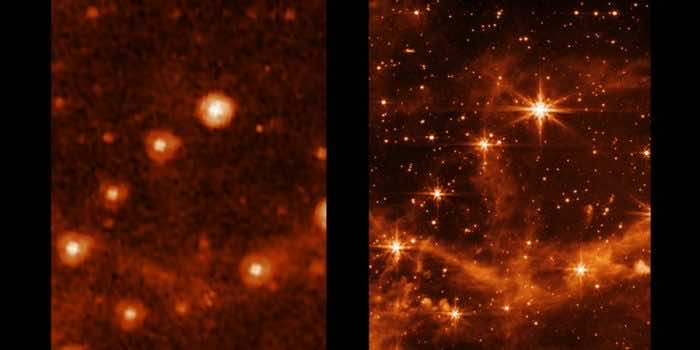The James Webb Telescope has once again demonstrated its lenses’ optic excellence and sharpness. The tested flying observatory has delivered the most recent test images of a neighbouring satellite galaxy. The results are astounding when contrasted to those obtained by NASA’s earlier infrared observatory.
“It’s not until you actually see the kind of image that it delivers that you really internalize and go ‘wow!’” said University of Arizona’s Marcia Rieke, chief scientist for Webb’s near-infrared camera.
“Just think of what we’re going to learn.”
The scientists captured the image while focusing on Webb’s coldest equipment, the Mid-Infrared Instrument (MIRI). The instrument detected a dense starfield in the Large Magellanic Cloud.
The decommissioned Spitzer telescope, which was the first to give high-resolution photographs of the near- and mid-infrared universe, also caught the same patch of sky.
According to NASA, Webb’s substantially larger primary mirror and upgraded detectors will allow us to observe the infrared sky with greater clarity, allowing for even more scientific breakthroughs.
The current image provides remarkable detail of interstellar gas, which was previously missing from the Spitzer image. “You can observe emissions from polycyclic aromatic hydrocarbons, or carbon and hydrogen molecules, which play a key role in interstellar space’s thermal balance and chemistry,” NASA noted.
The $10 billion Webb space telescope, launched last December, is the world’s largest and most powerful astronomical observatory. It will look for light released by the first stars and galaxies around 14 billion years ago and any signs of life beyond Earth.

While the James Webb Team has remained tight-lipped about the telescope’s first target, the timetable of the telescope’s missions has been made public. The world’s most powerful observatory, placed at the second Lagrange point, is now fully operational, allowing scientists to view deep into the universe.
Update: The title of the article has been updated to reflect the fact that the images are of a neighboring satellite galaxy and not specifically the Andromeda galaxy as previously labeled.


